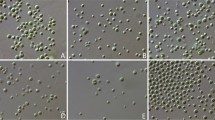Abstract
The tropical marine sponge Dysidea herbacea (Keller) (Dictyoceratidae: Dysideidae) is always found associated with the filamentous cyanobacterium (blue-green alga) Oscillatoria spongeliae (Schulze) Hauck (Cyanophyceae: Oscillatoriaceae), which occurs abundantly throughout the sponge mesohyl. Intact, metabolically active, trichomes of O. spongeliae were isolated from the sponge by chopping the sponge tissue with a razor blade and squeezing the trichomes into a seawater-based medium containing polyvinylpyrrolidone, bovine serum albumin, dithiothreitol, glycerol, KCl and Na2CO3. The isolated cyanobacteria were concentrated by centrifugation and then washed several times in fresh medium. The isolated O. spongeliae have photosynthetic rates which are similar to the intact sponge-alga association for periods of at least 6 h after isolation. Addition of sponge homogenate to the isolated cyanobacteria causes rapid cell lysis.
Similar content being viewed by others
References
Berthold RJ, Borowitzka MA, Mackay MA (1982) The ultrastructure of Oscillatoria spongeliae, the blue-green algal endosymbiont of the sponge Dysidea herbacea. Phycologia 21: 327–335.
Borowitzka MA (1988) Algal growth media and sources of cultures. In: Borowitzka MA, Borowitzka LJ (eds) Micro-algal biotechnology. Cambridge University Press, Cambridge, p 456–465
Borowitzka MA, Hinde R, Pironet F (1989) Carbon fixation by the sponge Dysidea herbacea and its endosymbiont Oscillatoria spongeliae. In: Choat JH, Barnes DJ, Borowitzka MA, Coll JC, Davies PJ, Flood P, Hatcher BG, Hopley D, Hutchings PA, Kinsey D, Orme GR, Pichon M, Sale PF, Sammarco PW, Wallace CC, Wilkinson CR, Wolanski E, Bellwood O (eds) Proceedings of the Sixth International Coral Reef Symposium, Townsville. Sixth International Coral Reef Symposium Executive Committee, Townsville, p 151–156
Carpenter JH (1966) New measurements of oxygen solubility in pure and natural waters. Limnol Oceanogr 11: 264–277
Carté B, Faulkner DJ (1981) Polybrominated diphenyl ethers from Dysidea herbacea, Dysidea chlorea and Phyllospongia foliaescens. Tetrahedron 37: 2335–2339
Charles C, Braekman JC, Daloze D, Tursch B, Karlsson R (1978) Chemical studies of marine invertebrates. XXXII. Isodysidenin, a futher hexachlorinated metabolite from the sponge Dysidea herbacea. Tetrahedron Lett 17: 1519–1520
Cheshire AC, Wilkinson CR (1991) Modelling the photosynthetic production by sponges on Davies Reef, Great Barrier Reef. Mar Biol 109: 13–18
Crumeyrolles-Duclaux C (1970) Sur la position systematique des zooxanthelles de Cliona viridis (Schm.), Spongiaire. Cr hebd Séanc Acad Sci, Paris 270: 1238–1239
De Laubenfels MW (1954) The sponges of the West Central Pacific. Ore St Monogr Stud Zool 7: 1–306
Dunlop RW, Kazlauskas R, March G, Murphy PT, Wells RJ (1982) New furano sesquiterpenes from the sponge Dysidea herbacea. Aust J Chem. 35: 95–103
Grant BR, Borowitzka MA (1984) Changes in isolated chloroplasts of Codium fragile and Caulerpa filiformis in response to osmotic shock and detergent treatment. Protoplasma 120: 155–164
Hinde R (1983) Host release factors in symbioses between algae and invertebrates. Endocytobiology 2: 709–726
Hofheinz W, Oberhänsli WE (1977) Dysidenin, a novel chlorine containing natural product from the sponge Dysidea herbacea. Helv chim Acta 60: 660–669
Jeffrey SW, Humphrey GF (1975) New spectrophotometric equations for determining chlorophylls a, b, c1 and c2 in higher plants, algae and natural populations. Biochem Physiol Pfl 167: 191–194
Kazlauskas R, Lidgard RO, Wells RJ, Vetter W (1977) A novel hexachloro-metabolite from the sponge Dysidea herbacea. Tetrahedron Lett 36: 3183–3186
Larkum AWD, Cox GC, Hiller RG, Parry DL, Dibbayawan TP (1987) Filamentous cyanophytes containign phycourobilin and in symbiosis with sponges and an ascidian of coral reefs. Mar Biol 95: 1–13
Larkum AWD, Wyn Jones RG (1979) Carbon dioxide fixation by chloroplasts isolated by glycinebetaine. A putative cytoplasmic osmoticum. Planta 145: 393–394
Norton RS, Croft KD, Wells RJ (1981). Polybrominated oxydiphenol derivatives from the sponge Dysidae herbacea. Structure determination by analysis of 13C spin-lattice relaxation data for quaternary carbons and 13C−H coupling constants. Tetrahedron 37: 2341–2349
Price IR, Fricker RL, Wilkinson CR (1984) Ceratodictyon spongiosum (Rhodophyta), the macroalgal partner in an alga-sponge symbiosis, grown in unialgal culture. J Phycol 20: 156–158
Rützler K (1990) Associations between Caribbean sponges and photosynthetic organisms. In: Rützler K (ed) New perspectives in sponge biology. Smithsonian Institution Press, Washington, DC, p 455–466
Scott FJ, Wetherbee R (1982) The structure of sponge — red alga associations observed in selected seaweeds from Southern and Western Australia. Micron 13: 331–332
Sharma GM, Vig B (1972) Studies on the antimicrobial substances of sponges. VI. Structures of two antibacterial substances isolated from the marine sponge Dysidea herbacea. Tetrahedron Lett 17: 1715–1718
Smith RV, Foy RH (1974) Improved hydrogen ion buffering of media for the culture of freshwater algae. Br Phycol J 9: 239–245
Spurr AR (1969) Low viscosity epoxy resin embedding medium for electron microscopy. J Ultrastruct Res 26: 31–43
Wilkinson CR (1983) Net primary productivity in coral reef sponges. Science, NY 219: 410–412
Author information
Authors and Affiliations
Additional information
Communicated by G. F. Humphrey, Sydney
Rights and permissions
About this article
Cite this article
Hinde, R., Pironet, F. & Borowitzka, M.A. Isolation of Oscillatoria spongeliae, the filamentous cyanobacterial symbiont of the marine sponge Dysidea herbacea . Marine Biology 119, 99–104 (1994). https://doi.org/10.1007/BF00350111
Received:
Accepted:
Issue Date:
DOI: https://doi.org/10.1007/BF00350111




